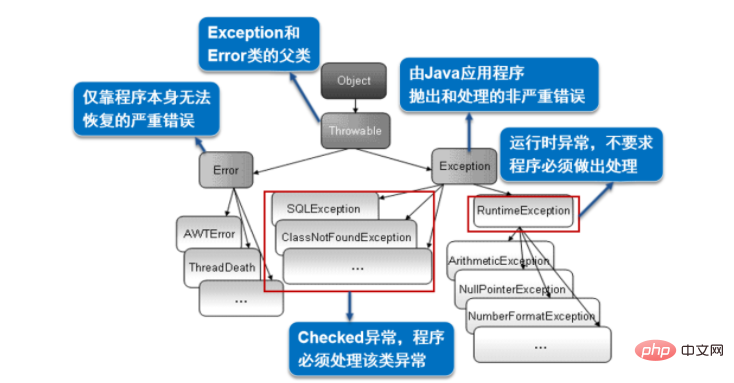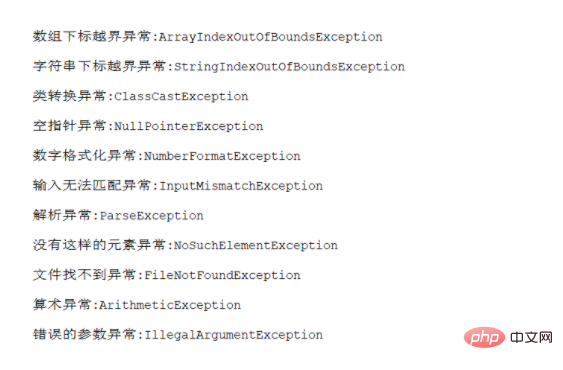Example analysis of Java exception handling mechanism
The underlying principle of the exception handling mechanism
Throws an exception. When executing a method, if an exception is sent, this method generates an object representing the exception and stops the current execution. path and submit the exception to jre.
Catch exception: After jre gets the exception, it feints the corresponding code to handle the exception. jre searches in the call stack of the method and traces back from the method that generated the exception until it finds the corresponding exception handling code.
Exception inheritance diagram

Ok, we now know what the definition of exception is, so how should we go about it? Catch exceptions and then handle them.
Exception handling
1. try-catch-finally structure
First we look at a piece of code:
package AbnormalTest;
import java.util.InputMismatchException;
import java.util.Scanner;
public class test1 {
public static void main(String[] args) {
Scanner input = new Scanner(System.in);
try {
System.out.print("请输入被除数:");
int a = input.nextInt();
System.out.print("请输入除数:");
int b = input.nextInt();
int sum = b/a;
System.out.println("结果是:"+sum);
System.out.println("程序无异常,执行完毕!");
}catch (Exception e){ //通用异常
//printStackTrace()方法是将堆栈异常的错误信息打印出来(后期学习框架后我们一般提交或 者回滚事务)
e.printStackTrace();
System.out.println("程序异常,请重试!");
return ;
}finally {
//不管是否发生了异常,都会执行finally内的代码,通常用于资源的关闭
System.out.println("------------------------------");
System.out.println("程序结束,资源已经关闭,欢迎再次使用");
input.close(); //关闭Scanner对象,节省资源
}
}
}Code explanation:
There are try-catch-finally structures in the above code. What are their respective functions?
try: We use try to include code that may cause exceptions
catch: As long as an exception occurs when the code in the try code block is running, catch will be entered to catch the exception
finally: No matter how the previous code is executed, the finally code block will be executed! !
Example of running results:
Normal time:

Abnormal time:
When the dividend is 0, An exception will be triggered and captured in catah, but no matter whether there is an exception or not, the program output in finally will be executed: the program is over, the resource has been closed, you are welcome to use it again

II , Multi-catch handles different exceptions:
We know that there may be more than one exception in a piece of code. For example, in the above code, there may be an exception where the dividend is divided by 0, or there may be an input exception when characters are entered for calculation, or there may be There are digital formatting exceptions, etc., so we can use multiple catches to catch exceptions:
Still take the above code as an example:
import java.util.InputMismatchException;
import java.util.Scanner;
public class test1 {
public static void main(String[] args) {
Scanner input = new Scanner(System.in);
try {
System.out.print("请输入被除数:");
int a = input.nextInt();
System.out.print("请输入除数:");
int b = input.nextInt();
int sum = b/a;
System.out.println("结果是:"+sum);
System.out.println("程序无异常,执行完毕!");
}catch (InputMismatchException e){ //多重catch结构,这里捕捉输入异常
e.printStackTrace();
System.out.println("程序输入异常,请重试!");
}catch (Exception e){ //这里捕捉通用异常(其他异常都可以在这里进行捕捉)
e.printStackTrace();
System.out.println("程序异常,请重试!");
return ;
}finally {
//不管是否发生了异常,都会执行finally内的代码,通常用于资源的关闭
System.out.println("------------------------------");
System.out.println("程序结束,资源已经关闭,欢迎再次使用");
input.close(); //关闭Scanner对象,节省资源
}
}
}When the input is not a number:

In this way we can see that it has been caught in the first catch
3. throws declares exception/throw throws exception:
Suppose I define a method and inform that the method may send some kind of exception (declared exception). The caller must handle the exception when calling the method.
First we define an error class:
Student class:
package ExceptionText;
/**
* 异常测试
*/
public class Student {
private String name;
private int age;
private char sex;
public void setName(String name) {
this.name = name;
}
public String getName() {
return name;
}
public int getAge() {
return age;
}
public char getSex() {
return sex;
}
public void setAge(int age) throws Exception {
if (age < 101 && age > 0) {
this.age = age;
} else {
throw new Exception("年龄输入有误!");
}
}
public void setSex(char sex) throws Exception {
if (sex == '男' || sex == '女') {
this.sex = sex;
} else {
throw new Exception("性别输入有误");
}
}
}Test class:
package ExceptionText;
public class TestMain {
public static void main(String[] args) {
Student stu = new Student();
stu.setName("小红");
try {
stu.setAge(50);
stu.setSex('k');
System.out.println("我叫:"+stu.getName()+"年龄:"+stu.getAge()+"我的性别是:"+stu.getSex());
} catch (Exception e) {
e.printStackTrace();
}
}
}When the entry and exit are correct:

When the age is entered incorrectly:

When the gender is entered incorrectly:

Note: If there are multiple exceptions, the first one that occurs will be thrown.
4. Custom exceptions:
When the runtime exception subclass of RuntimeException cannot meet our needs, we can also customize runtime exceptions and throw custom exceptions Information to meet our needs, but please note: Custom runtime exceptions must inherit RuntimeException! ! !
Custom exception class:
//这个类是继承了RuntimeException
public class AgeException extends RuntimeException {
//构造方法
public AgeException(String message) {
super(message);
}
}Student information class:
package CustomizeException;
public class Student {
private String name;
private int age;
private char sex;
public void setName(String name) {
this.name = name;
}
public String getName() {
return name;
}
public int getAge() {
return age;
}
public char getSex() {
return sex;
}
//方法
//使用throws 来声明异常,就是这个方法内可能存在异常,先事先声明
public void setAge(int age) throws Exception {
if (age < 101 && age > 0) {
this.age = age;
} else { //如果不符合上面的if判断
throw new Exception("年龄输入有误!"); //这里就要用thrwo 来抛出异常,
}
}
public void setSex(char sex) throws Exception {
if (sex == '男' || sex == '女') {
this.sex = sex;
} else {
throw new AgeException("这是自定义异常,性别输入有误");
}
}
}Test class:
package ExceptionText;
public class TestMain {
public static void main(String[] args) {
Student stu = new Student();
stu.setName("小红");
try {
stu.setAge(18);
stu.setSex('女');
System.out.println("我叫:"+stu.getName()+"年龄:"+stu.getAge()+"我的性别是:"+stu.getSex());
} catch (Exception e) {
e.printStackTrace();
}
}
}The code in this part is consistent with the third part above , you can refer to the above example.
5. Common exceptions

The above is the detailed content of Example analysis of Java exception handling mechanism. For more information, please follow other related articles on the PHP Chinese website!

Hot AI Tools

Undresser.AI Undress
AI-powered app for creating realistic nude photos

AI Clothes Remover
Online AI tool for removing clothes from photos.

Undress AI Tool
Undress images for free

Clothoff.io
AI clothes remover

Video Face Swap
Swap faces in any video effortlessly with our completely free AI face swap tool!

Hot Article

Hot Tools

Notepad++7.3.1
Easy-to-use and free code editor

SublimeText3 Chinese version
Chinese version, very easy to use

Zend Studio 13.0.1
Powerful PHP integrated development environment

Dreamweaver CS6
Visual web development tools

SublimeText3 Mac version
God-level code editing software (SublimeText3)

Hot Topics
 1664
1664
 14
14
 1423
1423
 52
52
 1318
1318
 25
25
 1269
1269
 29
29
 1248
1248
 24
24
 Break or return from Java 8 stream forEach?
Feb 07, 2025 pm 12:09 PM
Break or return from Java 8 stream forEach?
Feb 07, 2025 pm 12:09 PM
Java 8 introduces the Stream API, providing a powerful and expressive way to process data collections. However, a common question when using Stream is: How to break or return from a forEach operation? Traditional loops allow for early interruption or return, but Stream's forEach method does not directly support this method. This article will explain the reasons and explore alternative methods for implementing premature termination in Stream processing systems. Further reading: Java Stream API improvements Understand Stream forEach The forEach method is a terminal operation that performs one operation on each element in the Stream. Its design intention is
 PHP: A Key Language for Web Development
Apr 13, 2025 am 12:08 AM
PHP: A Key Language for Web Development
Apr 13, 2025 am 12:08 AM
PHP is a scripting language widely used on the server side, especially suitable for web development. 1.PHP can embed HTML, process HTTP requests and responses, and supports a variety of databases. 2.PHP is used to generate dynamic web content, process form data, access databases, etc., with strong community support and open source resources. 3. PHP is an interpreted language, and the execution process includes lexical analysis, grammatical analysis, compilation and execution. 4.PHP can be combined with MySQL for advanced applications such as user registration systems. 5. When debugging PHP, you can use functions such as error_reporting() and var_dump(). 6. Optimize PHP code to use caching mechanisms, optimize database queries and use built-in functions. 7
 PHP vs. Python: Understanding the Differences
Apr 11, 2025 am 12:15 AM
PHP vs. Python: Understanding the Differences
Apr 11, 2025 am 12:15 AM
PHP and Python each have their own advantages, and the choice should be based on project requirements. 1.PHP is suitable for web development, with simple syntax and high execution efficiency. 2. Python is suitable for data science and machine learning, with concise syntax and rich libraries.
 PHP vs. Other Languages: A Comparison
Apr 13, 2025 am 12:19 AM
PHP vs. Other Languages: A Comparison
Apr 13, 2025 am 12:19 AM
PHP is suitable for web development, especially in rapid development and processing dynamic content, but is not good at data science and enterprise-level applications. Compared with Python, PHP has more advantages in web development, but is not as good as Python in the field of data science; compared with Java, PHP performs worse in enterprise-level applications, but is more flexible in web development; compared with JavaScript, PHP is more concise in back-end development, but is not as good as JavaScript in front-end development.
 PHP vs. Python: Core Features and Functionality
Apr 13, 2025 am 12:16 AM
PHP vs. Python: Core Features and Functionality
Apr 13, 2025 am 12:16 AM
PHP and Python each have their own advantages and are suitable for different scenarios. 1.PHP is suitable for web development and provides built-in web servers and rich function libraries. 2. Python is suitable for data science and machine learning, with concise syntax and a powerful standard library. When choosing, it should be decided based on project requirements.
 PHP's Impact: Web Development and Beyond
Apr 18, 2025 am 12:10 AM
PHP's Impact: Web Development and Beyond
Apr 18, 2025 am 12:10 AM
PHPhassignificantlyimpactedwebdevelopmentandextendsbeyondit.1)ItpowersmajorplatformslikeWordPressandexcelsindatabaseinteractions.2)PHP'sadaptabilityallowsittoscaleforlargeapplicationsusingframeworkslikeLaravel.3)Beyondweb,PHPisusedincommand-linescrip
 Java Program to Find the Volume of Capsule
Feb 07, 2025 am 11:37 AM
Java Program to Find the Volume of Capsule
Feb 07, 2025 am 11:37 AM
Capsules are three-dimensional geometric figures, composed of a cylinder and a hemisphere at both ends. The volume of the capsule can be calculated by adding the volume of the cylinder and the volume of the hemisphere at both ends. This tutorial will discuss how to calculate the volume of a given capsule in Java using different methods. Capsule volume formula The formula for capsule volume is as follows: Capsule volume = Cylindrical volume Volume Two hemisphere volume in, r: The radius of the hemisphere. h: The height of the cylinder (excluding the hemisphere). Example 1 enter Radius = 5 units Height = 10 units Output Volume = 1570.8 cubic units explain Calculate volume using formula: Volume = π × r2 × h (4
 PHP: The Foundation of Many Websites
Apr 13, 2025 am 12:07 AM
PHP: The Foundation of Many Websites
Apr 13, 2025 am 12:07 AM
The reasons why PHP is the preferred technology stack for many websites include its ease of use, strong community support, and widespread use. 1) Easy to learn and use, suitable for beginners. 2) Have a huge developer community and rich resources. 3) Widely used in WordPress, Drupal and other platforms. 4) Integrate tightly with web servers to simplify development deployment.




